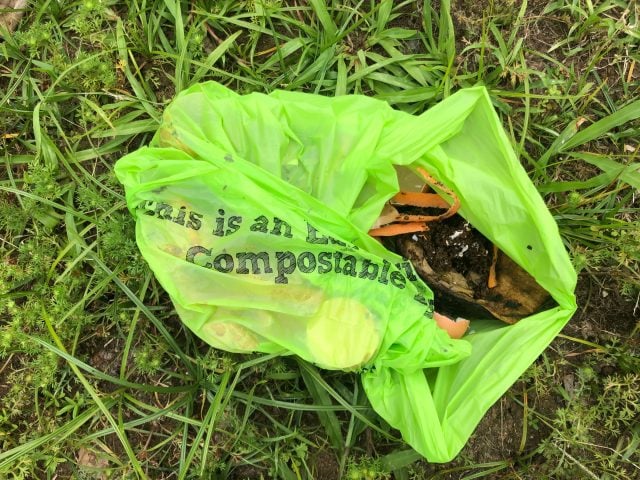
Brought to you by Cosmos Magazine and The Echo
Single use isn’t it.
Composting shouldn’t need to be complicated. You put all your food waste in a pile, mix it with some leaves and turn it occasionally while bacteria and fungi do their thing to break it back into soil.
But compostable plastics opens a whole can of worms.
A study published last week in Frontiers of Sustainability looked at how “bioplastics” — so-called biodegradable plastic which breaks down in specific conditions — were able to be home composted. When the small army of citizen scientists who helped with the project peeled back the worm blanket, they found that bioplastic seemed both overhyped and unable to deliver.
The researchers found that 60% of home-compostable plastic does not fully disintegrate in home compost bins. Composters who were part of the study were also confused about what sort of bioplastics can be put in a home compost bin, with some trying to compost products made for industrial composting. The team were so underwhelmed with the result, they asked ‘what economic or environmental problem do biodegradable plastics solve?’
The researchers undertook a project called the ‘Big Compost Experiment’ between 2019 and 2021. Almost 10,000 UK residents were part of a survey to gauge thoughts and opinions about compostable packaging. About 900 people completed a home composting experiment, where they placed a piece of home compostable packaging into a mesh bag and placed it into their compost for decomposition.
“Our data also shows that citizens are confused about what the labels on compostable and biodegradable packaging mean. For example, 60% of sampled items tested in home composting experiments were not certified home compostable,” the team write in the new paper.
“Our evidence [shows] citizens don’t understand these complexities of compostable or biodegradable packaging and yet are enthusiastic about buying them (85% reported doing so).”
The results were stark. A whopping 55% of the samples labelled as ‘home compostable’ were found to be still ‘clearly visible’ after the composting time period (between 3 and 21 months), while another 11% still showed small pieces. Only 34% had seemingly composted completely.
Read more: Plastic versus bioplastic
Is Australia any better?
“[The 60% result] does not surprise me as it echoes anecdotal evidence I have heard often in Australia,” Jennifer Macklin, a researcher at the Monash Sustainable Development Institute who focuses on recycling, told Cosmos.
“Part of the reason is that home compostable certification assumes certain ‘typical’ (or ideal) conditions attained in a home compost, and it is likely that some or even many home composts are not reaching these conditions due to lack of knowledge or time, local environment, and climate.
“The certification system assumes that the item will spend a certain amount of time in these conditions, time that is usually longer than needed to break down garden and/or food waste, and home composters may be used to much shorter timeframes. This doesn’t mean the certification is ‘false’ just that the ‘criteria’ may not be realistic enough given the diversity of home composting experiences.”
The researchers highlight that this is particularly a problem if the un-composted plastic is being spread onto vegetable gardens or fruit trees. Microplastics are already being found in our water, food and poo, but there’s also questions about what sort of chemicals could be leaching into the soil from the half-composted plastic. The researchers found (in England) that 83% of composters use their compost to grow edible plants, fruits, and vegetables.
Compostable plastic is also not widely used in larger industrial composting – so you also can’t just throw any compostable plastic into a council organics bin.
“Even if an organics processor could theoretically compost the item, they have no way of separating certified products from uncertified products in their waste stream,” says Macklin.
“So, they have to ban all plastic-looking products in order to ensure that they don’t end up with traditional plastic contaminating their organics.”
According to Richard Fine, the founder of compostable packaging company Biopak, this is not the case in some places, like South Australia.
“Some states like SA they are far more advanced and are able to accept certified compostable packaging in the [Food Organics Garden Organics] FOGO kerbside collections,” he told Cosmos via email.
“Claims regarding the degradation of plastics can be highly confusing and understanding the difference can actually be quite simple.
“The seedling logo (industrially compostable) is an international certification and symbol to clearly identify certified compostable materials. We also have a different certification and logo used for products certified home compostable.”
Single use bioplastic
The problem at the heart of all this is the idea that we just need to swap one material for another, and that this new material will be better for the planet. The current trend is “single use” bioplastics or compostable plastics.
If the plastic is made from plants and can be composted in a regular composting pile, the system is theoretically better for the planet.
“The idea that a material can be sustainable is a widespread misconception,” the researchers write in their new paper.
“Only a [whole] system of production, collection, and reprocessing of a material can be sustainable.”
Both Macklin and the researchers highlight circumstances where compostable plastics can be useful. Macklin points to food courts and commercial kitchens, where the entire circular economy of the ecosystem can be managed. The researchers suggest packaging that cannot be recycled because of contamination — like fruit stickers, tea bags, nappies, or wipes.
But in most cases “single use” is still not the way to go. “The most impactful way to reduce footprint is to use long-lasting, reusable products for as long as possible,” says Macklin.
This article was originally published on Cosmos Magazine and was written by Jacinta Bowler. Jacinta Bowler is a science journalist at Cosmos. They have a undergraduate degree in genetics and journalism from the University of Queensland and have been published in the Best Australian Science Writing 2022.





“Compostable plastic’, its another go at greenwashing by the masters of spin, the Fossil Fuel Industry.
Yes , of course you call out the obvious Joachim.
You would think it unnecessary to state the nonsense of expecting ‘ carbon capture and storage’ , agricultural improvements to store carbon in soil, the indefensible schemes to claim ‘ carbon credits’ by mobilising ‘ community ‘ members to systematically indulge in arson, on a grand scale, for fun and profit and perversely claim that these ‘carbon credits’ are somehow beneficial for the incinerated environment, but apparently these ruses are not so obvious to a large, easily duped group.
Admittedly this may distract native people from their industrial scale enterprises of hunting and processing protected species ,such as turtles and dugongs’ for an Australia wide distribution network , but in my estimation either of these activities are equally reprehensible and totally unforgivable crimes against nature.
This method of perverted government claims of ameliorating climate damage by funding even more destruction by the perpetrators, is systematic and due, I believe, to their total disdain of any appearance of acting in any manor that could be labelled GREEN or environmentally aware. Dubious claims are seized upon and used to validate inaction and even more excesses in the destruction of life on Earth.
Cheers, G”)
Ken, ‘carbon capture and storage’ (CCS), nice that you should mention it.
CCS is another FF Industry greenwasher, spinner, excuser, to keep on doing Business As Usual.
Over in Western Australia we have a monumental CCSFAIL in Chevron’s Gorgon Methane Project.
A condition of approval for this Methane Bomb was that it would capture and store its carbon dioxide emissions underground.
In its 6 years of operating only 1/3 of its emissions have been captured and stored underground, the rest of the emissions have been captured….. and stored in the SKY ABOVE!
So, condition of approval ( it doesn’t get more important than Climate Damage ) NOT meet, you’d ask why hasn’t this failed and ongoing polluting project been shutdown by the WA Government who set that very condition of approval for the project?
The emissions have been released, continue to be released, the climate damage can’t be undone and it continues on.
The Fossil Fuel Industry is seemingly, U n t o u c h a b l e.